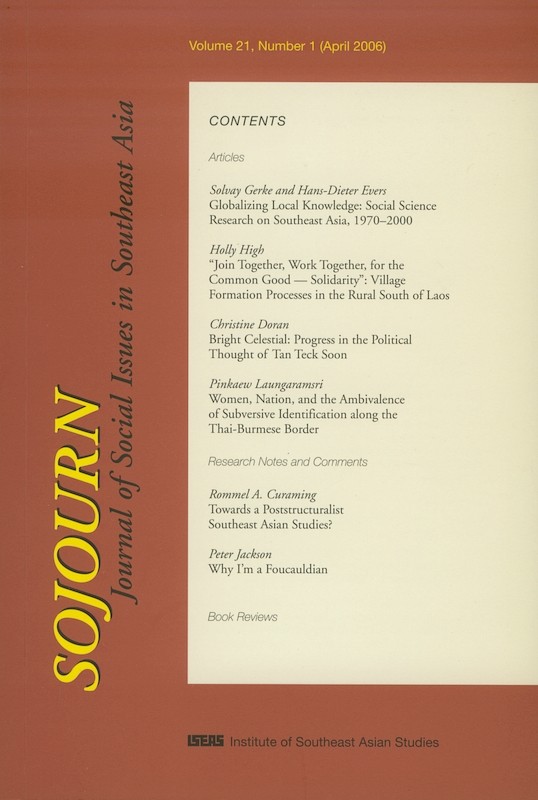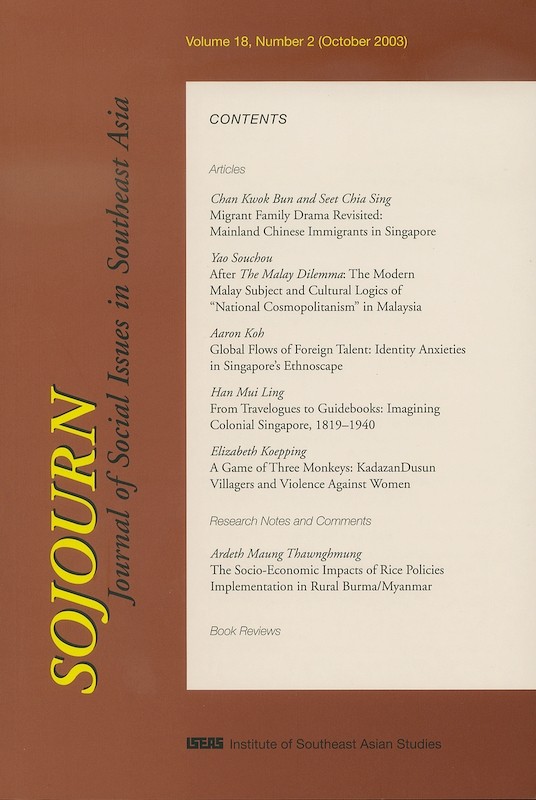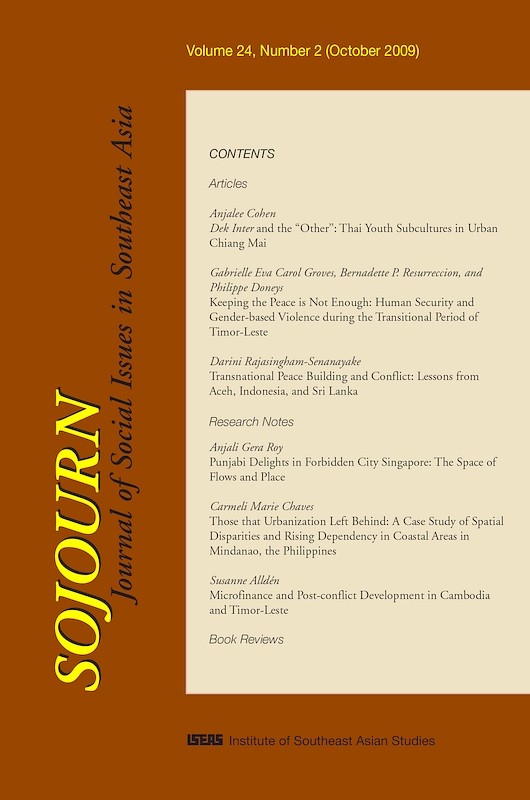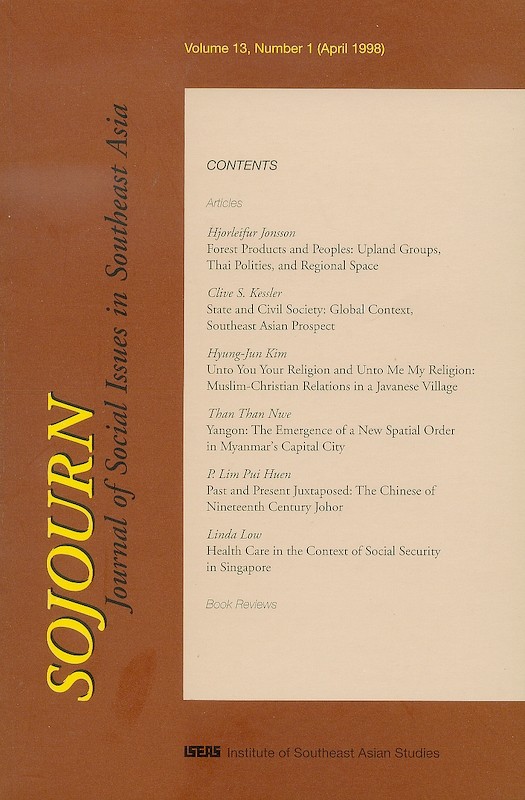SOJOURN: Journal of Social Issues in Southeast Asia Vol. 18/1 (April 2003)
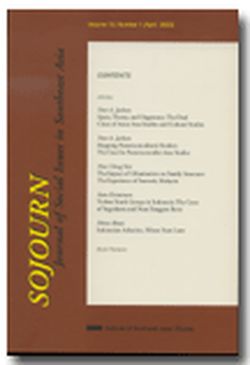
Date of publication:
May 2003
Publisher:
Institute of Southeast Asian Studies
Number of pages:
170
Code:
SJ18/1
Contents
-
SOJOURN: Journal of Social Issues in Southeast Asia Vol. 18/1 (April 2003)
-
Preliminary pages
- ARTICLES
-
Space, Theory, and Hegemony: The Dual Crises of Asian Area Studies and Cultural Studies, by Peter A Jackson, author see abstractThe classical form of area studies based on the notion of culture-language areas has been critiqued by globalization theorists and poststructuralists as old-fashioned (pre-globalization) and theoretically naive (empirical). However, the death of area studies would leave students of Asian societies in a theoretically and politically fraught situation. While the essentialism of classical area studies must be abandoned, the critiques presented by globalization and poststructuralist theorists often presume that capitalist globalization entails the erasure of borders, the homogenization of cultures, and the end of spatiality as a domain of theoretically significant difference. These views are critiqued as ideologically driven and empirically unfounded. Geography remains a theoretically significant domain of discursive and cultural difference under globalization. A theoretically sophisticated area studies project therefore remains an essential method for understanding the twenty-first century world.
-
Mapping Poststructuralism's Borders: The Case for Poststructuralist Area Studies, by Peter A Jackson, author see abstractThe growth of highly formalized varieties of deconstructionist and Foucauldian analysis in Asian cultural studies is commonly based upon ideological accounts of capitalist globalization as entailing cultural homogenization. This implicit economic determinism supports the universalization of Western poststructuralist theory. In Asian cultural studies a conjuncture between globalization theory, Marxism and poststructuralism can operate as a parallel to, and implicit legitimation of, Western geopolitical hegemony. The application of poststructuralism outside its culture of origin reveals its capacity to obscure cultural difference despite rhetorical claims that this body of theorizing valorizes the importance of difference. In Asian studies the critical thrust of poststructuralism can be preserved by incorporating the notion of bordered spatialities as theoretically significant domains of difference between forms of discourse and culture. That is, in cross-cultural analysis the critical value of poststructuralism can be salvaged by drawing insights from the methods of area studies. A theoretical hybridization of poststructuralism and area studies can resist Euro-American theoretical hegemony.
-
The Impact of Urbanization on Family Structure: The Experience of Sarawak, Malaysia, by Hew Cheng Sim, author see abstractThis paper argues that women and men encounter the processes of migration and urbanization in very gendered ways. It examines state development policies and their role in accelerating the pace of urbanization. Using material from a recently concluded study on single mothers in the lower socioeconomic strata, this paper explores the impact of these wider processes on the structure of the family and women from this strata specifically.
-
Violent Youth Groups in Indonesia: The Cases of Yogyakarta and Nusa Tenggara Barat, by Stein Kristiansen, author see abstractProblems of violent youth groups have escalated in Indonesia, following economic recession, unemployment, and weakened state institutions. Young people have been hit by the lack of income and broken expectations. In consequence, youth groups emerge and arrange for members economic revenue as well as identity creation and confidence. Religion in some cases is used to legitimize violence and to strengthen the boldness of group members. The paper offers a brief overview of gangster (preman) traditions in Indonesia. Empirical findings on violent youth groups in the two selected provinces are presented within a multi-factor analytical framework, where the need for income and identity strengthening, political lite interests, and the lack of law enforcement contribute to explaining criminal and vigilante violence. Interviews with leaders and members of movements engaged in violent actions offer insights into a problem that threatens national security and control.
- RESEARCH NOTES AND COMMENTS
-
Indonesian Azharites, Fifteen Years Later, by Mona Abaza, author see abstractThis short note is a nostalgic return to the places where the Indonesian students in Cairo resided and studied. It hints at the significant change in the space and the ongoing transformation of the Indonesian student community in Cairo.
- BOOK REVIEWS
-
BOOK REVIEW: Keeping the Faith: Thai Buddhism at the Crossroads. By Sanitsuda Ekachai. Edited by Nick Wilgus. Bangkok: Post Books, 2002. 328 pp., by Jim Taylor, author
-
BOOK REVIEW: Dependence on Green Gold: A Socio-Economic History of the Indonesian Coconut Island Selayar. By Christiaan Heersink. Leiden: KITLV Press, 1999. xiii, 371 pp., by Roxana Waterson, author
-
BOOK REVIEW: Political Participation and Ethnic Minorities: Chinese Overseas in Malaysia, Indonesia, and the United States. By Amy Freedman. New York: Routledge, 2000. 224 pp., by Wendy K Tam Cho, author
-
BOOK REVIEW: King Siliman and Other Bidayuh Folk Tales, compiled by Robert Sulis Ridu, Ritikos Jitab, and Jonas Noeb. Dayak Studies Monographs, Oral Literature Series, no. 1, 2001. xvi, 138 pp; Suket: Penan Folk Stories, compiled by Jayl Langub. Dayak Studies Monographs, Oral Literature Series, no. 2, 2001. xii, 198 pp; Apai Alui Becomes a Shaman and Other Iban Comic Tales, compiled by Clifford Sather, Dayak Studies Monographs, Oral Literature Series, no. 3, 2001. xiii, 181 pp. All published by Kota Samarahan, Sarawak: Institute of East Asian Studies, Universiti Malaysia Sarawak., by Victor T King, author

